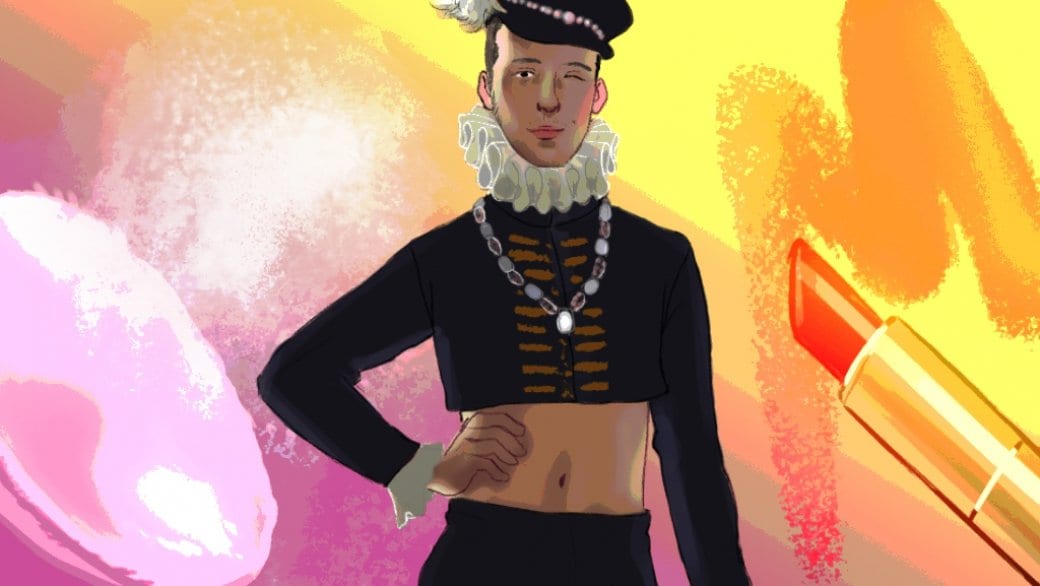“Your Highness, you seem to have changed your . . . ?”
“What’s that, underling?”
“Are you wearing —? ”
“Rouge and lipsticks and lovely, lovely jewelry? Why yes, I am.”
Setting aside the fact that it would be nice to have any power whatsoever, imagine how fun it would be to have so much power that you could just change your entire style and defy people to say anything about it. Just show up at your palace one day in full makeup and many strings of pearls as if it were the most natural thing in the world.
And the next thing you know, you have your own little entourage of nancy boys, all bejewelled and be-velvetted, and made up like fancy sex workers. While many of us would welcome it, it’s hard to imagine that even someone like the push-upping, wavy hair-having Justin Trudeau could get away with this kind of shift (too bad, Justin; you could really pull off a bold red lip).
Well, that’s just what King Henry III of France (not to be confused with King Henry III of England) did, and it was quite a shock. The young fighter had been elected the king of Poland (yes, elected) because of his many military victories, and when he subsequently inherited the title of king of France in 1574, they probably expected him to return home to France all swords and marching and fisticuffs.
But no. Instead, he went full transvestite (well not full, but that’s how many interpreted his appearance) and shirked military matters in favour of hanging out with poets and writers. He also gathered up a group of handsome young men — minor nobles — to be his confidants and playthings. They were generally referred to as the “mignons.” Sometimes “mignons de couchette” (bedroom favourites).
He and his mignons loved to throw naughty parties, and he lavished gifts on them. All of this made the other nobles uncomfortable, but the fun might have — I hope it would have — gone on without incident, if not for the many religious civil wars tearing up the country. Because of these conflicts, he made enemies by the day, and they used his apparent homosexuality against him and against the mignons.
If he supported the Huguenots, the Catholics let loose a torrent of damaging pamphlets. If he supported the Catholics, he upset the Huguenots. One sonnet describes the mignons as “shameless Ganymedes” (always a historical favourite, the insult was levelled at Pope Julius III’s companion only a short time before). Some made ominous comparisons between Henry and the earlier English king, Edward II, who was most likely homosexual and was murdered in a gruesomely suggestive manner.
In his Universal History, Huguenot poet-historian Agrippa d’Aubigné writes: “You would hear it said aloud that from the time that this prince had prostituted himself to unnatural love, and had even turned his pleasures to passive rather than active, one noted the loss of that courage which had been seen before the birth of these enormities.” I could be reading this incorrectly, but I think that with the “passive rather than active” bit he’s saying that the king became a weakling as soon as he became a big Nelly bottom.
But was he a big nelly bottom? Or a top? Or any sort of sodomite at all? He was probably homosexual, or bisexual, but it’s nearly impossible to be certain (as with so many historical figures). If he was, I prefer to think he got this tendency from his Medici mother — the Medici family having been a fairly gay bunch. And even if he didn’t have sex with his mignons — we can’t even be certain of this — I find the tender connection he had to them to be very sweet.
When the attacks on Henry and his mignons were getting really bad, Quélus, one of the mignons, and some of his friends got into a fight (a sort of gay bashing, perhaps?). Quélus was severely injured and Maugiron, who was probably Quélus’s lover, was killed. Henry’s affection for them both is evidenced by how lovingly he nursed Quélus. And then, after the young man died, Henry erected statues of the couple in a church in Paris.
In 1588, Henry was forced to leave Paris during the amusingly named War of the Three Henrys. He was assassinated a year later, at age 37. It’s a testament to his bond with his mignons that a couple of them, Épernon and Bellegarde, were at his bedside as he died. And it was these two mignons, rather than Henry’s successor, who moved his body to an appropriately royal tomb more than two decades later.
History Boys appears on Daily Xtra on the first and third Tuesday of every month. You can also follow them on Facebook.


 Why you can trust Xtra
Why you can trust Xtra


